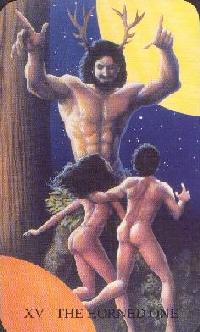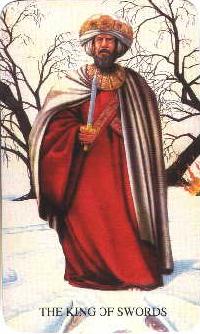Ellen Cannon Reed's
The Witches Tarot
A Deck Review
 The Witches Tarot represents an interesting and unique marriage of two
apparently unrelated schools of mystical thought - paganism and the Jewish
Qabalah. Ellen Cannon Reed has found the common ground between these two
religions and brought them together into a Tarot deck that resonates with
originality and beauty. Though a lot of the images do have a pagan touch
to them, it's hard to overlook the Qabalistic themes throughout the deck,
which are particularly rich in the Major Arcana.
The Witches Tarot represents an interesting and unique marriage of two
apparently unrelated schools of mystical thought - paganism and the Jewish
Qabalah. Ellen Cannon Reed has found the common ground between these two
religions and brought them together into a Tarot deck that resonates with
originality and beauty. Though a lot of the images do have a pagan touch
to them, it's hard to overlook the Qabalistic themes throughout the deck,
which are particularly rich in the Major Arcana.
Indeed, casual inspection reveals sections of colored circles in the edges
or corners of all 22 Major Arcana. These circles represent the spheres on
the Qabalistic Tree of Life and are present to show the reader which path
on the Tree a particular card represents. (Or, at least, which path the
author believes they represent. Reed's attributions are different from the
traditional attributions and this might cause problems for beginners who
would have to learn a whole new system.) Though the 56 Minor Arcana lack
such blatant Qabalistic content, Qabalistic themes are evident in a number
of the designs.
This is fortunate, because a lot of Ellen Reed's meanings are radically
different from "traditional" interpretations and, without at least a casual
knowledge of Qabalah, it's often hard to figure out where she has derived
some of the meanings she uses. For example, the Six of Swords in this deck
shows a Phoenix arising from flame, and a pelican piercing its breast to
feed its young. These are in sharp contrast to the traditional image of a
man or family on a boat. Only by realizing that the Six of Swords belongs
to Tiphareth, sphere of rebirth and sacrifice, can we find justification
for Reed's choice of image and interpretation.
 One thing I definitely don't like about this deck is the way the court cards
are handled. All four Kings, for example, look exactly the same, except
that their clothing is different and they are holding different suit items.
Even the backgrounds behind them are virtually identical. This seems to
imply that all of the court cards are very similar in meaning - which any
student of the Tarot can tell you is a false statement! The reason for this
uniformity of the courts is that Reed uses them as modifiers; they have no
meaning by themselves, because they serve to show how other energies in the
vicinity are developing.
One thing I definitely don't like about this deck is the way the court cards
are handled. All four Kings, for example, look exactly the same, except
that their clothing is different and they are holding different suit items.
Even the backgrounds behind them are virtually identical. This seems to
imply that all of the court cards are very similar in meaning - which any
student of the Tarot can tell you is a false statement! The reason for this
uniformity of the courts is that Reed uses them as modifiers; they have no
meaning by themselves, because they serve to show how other energies in the
vicinity are developing.
I don't really have a problem with this, because if this is the way Reed
chooses to read the cards, so be it. But I find that it is presumptuous of
the author to force her system on others, and not even provide some basic
divinatory meanings for her court cards. Actually, a part of me has felt
for a long time that Reed doesn't really understand the divinatory meanings
and significance of the courts, and therefore can't use them fully in her
own deck. This is just my personal belief and has no real basis in fact,
of course. But it is a fact that her deck embodies a whole new way to read
the courts which could easily confuse beginners.
Another stumbling block for beginners is that Reed assigns Swords to Fire
and Wands to Air - a choice that can be justified, and which is reflected
in many pagan decks, but which alters the meanings of the associated cards
to a considerable degree. Again, the biggest problem here is for a novice
who has just learned Swords in terms of Air qualities and must now learn
them in terms of Fire. It is mainly for this reason that I will conclude by
saying that The Witches Tarot is not a beginner's deck - it can be used by a
beginner, but to fully appreciate its strengths and recognize its weaknesses
the reader must have some experience.
Copyright 2000 James Rioux
 One thing I definitely don't like about this deck is the way the court cards
are handled. All four Kings, for example, look exactly the same, except
that their clothing is different and they are holding different suit items.
Even the backgrounds behind them are virtually identical. This seems to
imply that all of the court cards are very similar in meaning - which any
student of the Tarot can tell you is a false statement! The reason for this
uniformity of the courts is that Reed uses them as modifiers; they have no
meaning by themselves, because they serve to show how other energies in the
vicinity are developing.
One thing I definitely don't like about this deck is the way the court cards
are handled. All four Kings, for example, look exactly the same, except
that their clothing is different and they are holding different suit items.
Even the backgrounds behind them are virtually identical. This seems to
imply that all of the court cards are very similar in meaning - which any
student of the Tarot can tell you is a false statement! The reason for this
uniformity of the courts is that Reed uses them as modifiers; they have no
meaning by themselves, because they serve to show how other energies in the
vicinity are developing. The Witches Tarot represents an interesting and unique marriage of two
apparently unrelated schools of mystical thought - paganism and the Jewish
Qabalah. Ellen Cannon Reed has found the common ground between these two
religions and brought them together into a Tarot deck that resonates with
originality and beauty. Though a lot of the images do have a pagan touch
to them, it's hard to overlook the Qabalistic themes throughout the deck,
which are particularly rich in the Major Arcana.
The Witches Tarot represents an interesting and unique marriage of two
apparently unrelated schools of mystical thought - paganism and the Jewish
Qabalah. Ellen Cannon Reed has found the common ground between these two
religions and brought them together into a Tarot deck that resonates with
originality and beauty. Though a lot of the images do have a pagan touch
to them, it's hard to overlook the Qabalistic themes throughout the deck,
which are particularly rich in the Major Arcana.